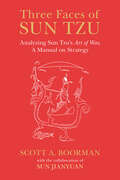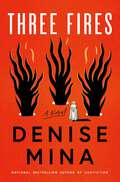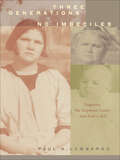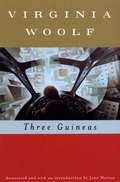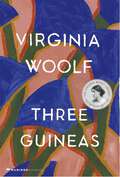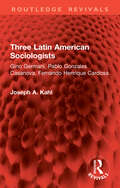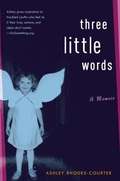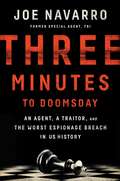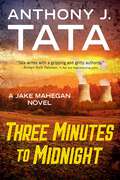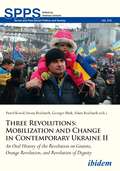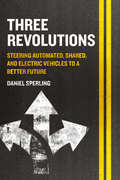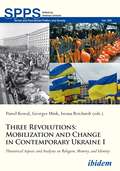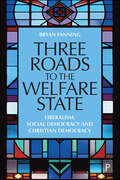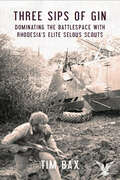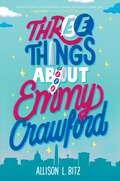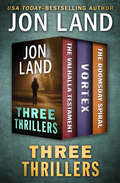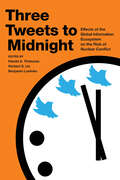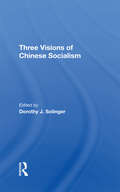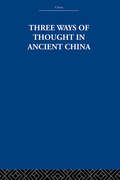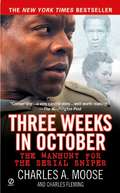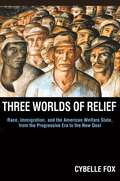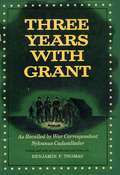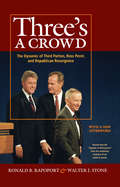- Table View
- List View
Three Faces of Sun Tzu: Analyzing Sun Tzu's Art of War, A Manual on Strategy
by Scott BoormanSun Tzu's Art of War is widely regarded as the most influential military & strategic classic of all time. Through 'reverse engineering' of the text structured around 14 Sun Tzu 'themes,' this rigorous analysis furnishes a thorough picture of what the text actually says, drawing on Chinese-language analyses, historical, philological, & archaeological sources, traditional commentaries, computational ideas, and strategic & logistics perspectives. Building on this anchoring, the book provides a unique roadmap of Sun Tzu's military and intelligence insights and their applications to strategic competitions in many times and places worldwide, from Warring States China to contemporary US/China strategic competition and other 21st century competitions involving cyber warfare, computing, other hi-tech conflict, espionage, and more. Simultaneously, the analysis offers a window into Sun Tzu's limitations and blind spots relevant to managing 21st century strategic competitions with Sun-Tzu-inspired adversaries or rivals.
Three Fires: A Novel
by Denise MinaFrom the award-winning master of crime fiction, Denise Mina re-imagines the "Bonfire of the Vanities,&” a series of fires lit throughout Florence at the end of the fifteenth century—inspired by the fanatical Girolamo Savonarola.Girolamo Savonarola was a Dominican friar living in Florence at the end of the fifteenth century. An anti-corruption campaigner, his hellfire preaching increasingly spilled over into tirades against all luxuries that tempted his followers toward sin. These sermons led to the infamous "Bonfire of the Vanities&”—a series of fires lit throughout Florence for the incineration of everything from books, extravagant clothing, playing cards, musical instruments, make-up, and mirrors to paintings, tapestries, and sculptures. Railing against the vice and avarice of the ruling Medici family, he was instrumental in their removal from power—and for a short time became the puritanical leader of the city. After turning his attention to corruption within the Catholic Church, he was first excommunicated and then executed by a combination of hanging and being burned at the stake. Just as in Rizzio—her latest novel with Pegasus Crime—Denise Mina brings a modern take to this fascinating historical story, drawing parallels between the febrile atmosphere of medieval Florence and the culture wars of the present day. In dramatizing the life and last days of Savonarola, she explores the downfall of the original architect of cancel culture and, in the process, explores the never-ending tensions between wealth, inequality, and freedom of speech that so dominate our modern world.
Three Generations, No Imbeciles: Eugenics, the Supreme Court, and Buck v. Bell
by Paul A. LombardoWinner, 2009 Georgia Author of the Year Award for Creative Nonfiction HistoryHonorable Mention, Nonfiction. Library of Virginia Literary Awards"Three generations of imbeciles are enough." Few lines from Supreme Court opinions are as memorable as this declaration by Justice Oliver Wendell Holmes Jr. in the landmark 1927 case Buck v. Bell. The ruling allowed states to forcibly sterilize residents in order to prevent "feebleminded and socially inadequate" people from having children. It is the only time the Supreme Court endorsed surgery as a tool of government policy. Paul Lombardo’s startling narrative exposes the Buck case’s fraudulent roots.In 1924 Carrie Buck—involuntarily institutionalized by the State of Virginia after she was raped and impregnated—challenged the state’s plan to sterilize her. Having already judged her mother and daughter mentally deficient, Virginia wanted to make Buck the first person sterilized under a new law designed to prevent hereditarily "defective" people from reproducing. Lombardo’s more than twenty-five years of research and his own interview with Buck before she died demonstrate conclusively that she was destined to lose the case before it had even begun. Neither Carrie Buck nor her mother and daughter were the "imbeciles" condemned in the Holmes opinion. Her lawyer—a founder of the institution where she was held—never challenged Virginia’s arguments and called no witnesses on Buck’s behalf. And judges who heard her case, from state courts up to the U.S. Supreme Court, sympathized with the eugenics movement. Virginia had Carrie Buck sterilized shortly after the 1927 decision.Though Buck set the stage for more than sixty thousand involuntary sterilizations in the United States and was cited at the Nuremberg trials in defense of Nazi sterilization experiments, it has never been overturned. Three Generations, No Imbeciles tracks the notorious case through its history, revealing that it remains a potent symbol of government control of reproduction and a troubling precedent for the human genome era.
Three Guineas (Annotated)
by Virginia Woolf Mark Hussey Dr Jane MarcusThree Guineas is written as a series of letters in which Virginia Woolf ponders the efficacy of donating to various causes to prevent war. In reflecting on her situation as the "daughter of an educated man" in 1930s England, Woolf challenges liberal orthodoxies and marshals vast research to make discomforting and still-challenging arguments about the relationship between gender and violence, and about the pieties of those who fail to see their complicity in war-making. This pacifist-feminist essay is a classic whose message resonates loudly in our contemporary global situation.Annotated and with an introduction by Jane Marcus
Three Guineas (Annotated): Large Print
by Virginia Woolf Jane Marcus Mark HusseyThree Guineas is written as a series of letters in which Virginia Woolf ponders the efficacy of donating to various causes to prevent war. In reflecting on her situation as the "daughter of an educated man" in 1930s England, Woolf challenges liberal orthodoxies and marshals vast research to make discomforting and still-challenging arguments about the relationship between gender and violence, and about the pieties of those who fail to see their complicity in war-making. This pacifist-feminist essay is a classic whose message resonates loudly in our contemporary global situation.Annotated and with an introduction by Jane Marcus
Three Latin American Sociologists: Gino Germani, Pablo Gonzales Casanova, Fernando Henrique Cardosa (Routledge Revivals)
by Joseph A. KahlOriginally published in 1976 under the title Modernization, Exploitation and Dependency in Latin America, and again in 1988 under the current title, the author describes, examines and introduces the life and work of three of the most important figures in the development of comparative politics and political sociology: Gino Germani (Argentina), Pablo Gonzales Casanova (Mexico) and Fernando Henrique Cardoso (Brazil). At the time of its first publication, the book introduced those three Latin American sociologists to the North American social and political science community. However, as Peter Evans points out in his introduction, the book had not lost its importance in the intervening years. Rather, the subsequent developments in comparative scholarship have only highlighted the influence of the three Latin Americans. The developments in comparative and political social science can virtually only be understood in the light of the influence that the thought of Germani, Gonzales Casanova and Cardoso had on the discussions in North America.
Three Lectures on Post-Industrial Society
by Daniel CohenIn this pithy and provocative book, noted economist Daniel Cohen offers his analysis of the global shift to a post-industrial era. If it was once natural to speak of industrial society, Cohen writes, it is more difficult to speak meaningfully of post-industrial "society." The solidarity that once lay at the heart of industrial society no longer exists. The different levels of large industrial enterprises have been systematically disassembled: tasks considered nonessential are assigned to subcontractors; engineers are grouped together in research sites, apart from the workers. Employees are left exposed while shareholders act to protect themselves. Never has the awareness that we all live in the same world been so strong---and never have the social conditions of existence been so unequal. In these wide-ranging reflections, Cohen describes the transformations that signaled the break between the industrial and the post-industrial eras. He links the revolution in information technology to the trend toward flatter hierarchies of workers with multiple skills--and connects the latter to work practices growing out of the culture of the May 1968 protests. Subcontracting and outsourcing have also changed the nature of work, and Cohen succinctly analyzes the new international division of labor, the economic rise of China, India, and the former Soviet Union, and the economic effects of free trade on poor countries. Finally, Cohen examines the fate of the European social model--with its traditional compromise between social justice and economic productivity--in a post-industrial world.
Three Little Words: A Memoir
by Ashley Rhodes-Courter"Sunshine, you're my baby and I your only mother. You must mind the one taking care of you, but she's not your mama. " Ashley Rhodes-Courter spent nine years of her life in fourteen different foster homes, living by those words. As her mother spirals out of control, Ashley is left clinging to an unpredictable, dissolving relationship, all the while getting pulled deeper and deeper into the foster care system. Painful memories of being taken away from her home quickly become consumed by real-life horrors, where Ashley is juggled between caseworkers, shuffled from school to school, and forced to endure manipulative, humiliating treatment from a very abusive foster family. In this inspiring, unforgettable memoir, Ashley finds the courage to succeed-and in doing so, discovers the power of her own voice. It only takes three little words to break free from the past.
Three Medieval Queens
by Lisa Benz St. JohnThis book is an innovative study offering the first examination of how three fourteenth-century English queens, Margaret of France, Isabella of France, and Philippa of Hainault, exercised power and authority. It takes advantage of a previously unstudied period of medieval queenship in which three queens, whose time as consorts and dowagers in England overlapped, creating a continuous transition from one queen to the next, and thus providing a unique opportunity to form conclusions about normative queenly behaviour and political culture. This study frames its examination around four major themes: gender; status; the concept of the crown; and power and authority.
Three Minutes to Doomsday: An Agent, a Traitor, and the Worst Espionage Breach in U.S. History
by Joe NavarroAn intense cat-and-mouse game played between two brilliant men in the last days of the Cold War, this shocking insider’s story shows how a massive giveaway of secret war plans and nuclear secrets threatened America with annihilation.In 1988 Joe Navarro, one of the youngest agents ever hired by the FBI, was dividing his time between SWAT assignments, flying air reconnaissance, and working counter-intelligence. But his real expertise was “reading” body language. He possessed an uncanny ability to glean the thoughts of those he interrogated. So it was that, on a routine assignment to interview a “person of interest”—a former American soldier named Rod Ramsay—Navarro noticed his interviewee’s hand trembling slightly when he was asked about another soldier who had recently been arrested in Germany on suspicion of espionage. That thin lead was enough for the FBI agent to insist to his bosses that an investigation be opened. What followed is unique in the annals of espionage detection—a two-year-long battle of wits. The dueling antagonists: an FBI agent who couldn’t overtly tip to his target that he suspected him of wrongdoing lest he clam up, and a traitor whose weakness was the enjoyment he derived from sparring with his inquisitor. Navarro’s job was made even more difficult by his adversary’s brilliance: not only did Ramsay possess an authentic photographic memory as well as the second highest IQ ever recorded by the US Army, he was bored by people who couldn’t match his erudition. To ensure that the information flow would continue, Navarro had to pre-choreograph every interview, becoming a chess master plotting twenty moves in advance. And the backdrop to this mental tug of war was the dissolution of the Soviet Union and the very real possibility that its leaders, in a last bid to alter the course of history, might launch a devastating attack. If they did, they would have Ramsay to thank, because as Navarro would learn over the course of forty-two mind-bending interviews, Ramsay had, by his stunning intelligence giveaways, handed the Soviets the ability to utterly destroy the US. The story of a determined hero who pushed himself to jaw-dropping levels of exhaustion and who rallied his team to expose undreamed of vulnerabilities in America’s defense, Three Minutes to Doomsday will leave the reader with disturbing thoughts of the risks the country takes even today with its most protected national secrets.
Three Minutes to Midnight (A Jake Mahegan Thriller #2)
by Anthony J. TataAn electrifying military thriller from the national bestselling author who &“writes with a gripping and gritty authority&” (Richard North Patterson, #1 New York Times–bestselling author). It begins with the kidnapping of an Army Reserve officer on U.S. soil. Name: Captain Maeve Cassidy. Profession: Geologist specializing in natural gas drilling and fracturing. Mission: classified. Abducted less than twenty-four hours upon her return from Afghanistan, Cassidy&’s disappearance from a Fort Bragg compound is more than a security breach. It is the first stage of a large-scale domestic attack that few Americans could imagine—or survive . . . Enter Delta Force veteran Jake Mahegan. The seasoned operative is on a personal mission of vengeance, tracking down his mother&’s killer at a drilling site in North Carolina. When he&’s assigned the task of locating the geologist, he can&’t help but wonder if her abduction is connected to the fracking magnate he&’s pursuing. But when a nearby nuclear plant is attacked, and then another, in a matter of days, Mahegan knows it&’s no coincidence. It is a brilliantly conceived, ruthlessly orchestrated assault on our homeland that no intelligence analyst could ever foresee—or stop . . . When a third nuclear plant is targeted, Mahegan has no choice but to try. If he fails, our nation falls. The countdown is launched. The clock is ticking. Armageddon begins . . . Three Minutes to Midnight. The Jake Mahegan thrillers are . . . &“Absolutely fantastic . . . pulse-pounding.&” —Brad Thor, #1 New York Times-bestselling author &“Explosive!&” —W.E.B. Griffin, #1 New York Times-bestselling author
Three Revolutions: An Oral History of the Revolution on Granite, Orange Revolution, and Revolution of Dignity (Soviet and Post-Soviet Politics and Society #210)
by Pawel KowalThe second part of this multivolume project assembles a series of recollections and debates on the Ukrainian revolutions of 1990, 2004, and 2013–2014. After an introduction to the methodology of oral history, it presents twenty interviews with participants and eyewitnesses of the events in Ukraine, and documents a series of workshop discussions conducted at a symposium held in 2017. In these workshops, activists and observers of each of the three revolutions exchanged and compared their memories, analyses, and evaluations. This volume thus not only provides a comprehensive collection of firsthand accounts of the three historic Ukrainian upheavals, but also reveals the interrelations between them. The volume documents assessments from Barbara Krauz-Mozer, Markiyan Ivashchyshyn, Natalia Klymovska, Vakhtang Kipiani, Mykola Kniazhycki, Natalyia Zubar, Yulia Tymoshenko, Aleksander Kwaśniewski, Viktor Taran, Markiyan Matsekh, Yulia Tychkivska, Leonid Findberg, Yulia Mostova, Oksana Zabuzhko, Eduard Drach, Michailo Cherenkoff, Andriy Dudchenko, Oleg Mahdych, Rebecca Harms, Herman van Rumpoy, and Jacek Saryusz-Wolski.
Three Revolutions: Steering Automated, Shared, And Electric Vehicles To A Better Future
by Daniel SperlingFor the first timein half a century, real transformative innovations are coming to our world of passenger transportation. The convergence of new shared mobility services with automated and electric vehicles promises to significantly reshape our lives and communities for the better—or for the worse.The dream scenario could bring huge public and private benefits, including more transportation choices, greater affordability and accessibility, and healthier, more livable cities, along with reduced greenhouse gas emissions. The nightmare scenario could bring more urban sprawl, energy use, greenhouse gas emissions, and unhealthy cities and individuals.In Three Revolutions, transportation expert Dan Sperling, along with seven other leaders in the field, share research-based insights on potential public benefits and impacts of the three transportation revolutions. They describe innovative ideas and partnerships, and explore the role government policy can play in steering the new transportation paradigm toward the public interest—toward our dream scenario of social equity, environmental sustainability, and urban livability.Many factors will influence these revolutions—including the willingness of travelers to share rides and eschew car ownership; continuing reductions in battery, fuel cell, and automation costs; and the adaptiveness of companies. But one of the most important factors is policy.Three Revolutions offers policy recommendations and provides insight and knowledge that could lead to wiser choices by all. With this book, Sperling and his collaborators hope to steer these revolutions toward the public interest and a better quality of life for everyone.
Three Revolutions: Theoretical Aspects and Analyses on Religion, Memory, and Identity (Soviet and Post-Soviet Politics and Society #209)
by Pawel KowalVolume One of Three Revolutions presents the overall research and discussions on topics related to the revolutionary events that have unfolded in Ukraine since 1990. The three revolutions referred to in this project include: the Revolution on Granite (1990); the Orange Revolution (2004–2005); and the Euromaidan Revolution (2013–2014). The project’s overall goal was to determine the extent to which we have the right to use the term “revolution” in relation to these events. Moreover, the research also uncovered the methodological problems associated with this task. Lastly, the project investigated to what extent the three revolutions are connected to each other and to what extent they are detached. Hence, the research in this volume not only discusses the theoretical aspects but also provides new analyses on such issues as religion, memory, and identity in Ukraine.
Three Roads to the Welfare State: Liberalism, Social Democracy and Christian Democracy
by Bryan FanningThe development of social policy in Europe is explored in this accessible intellectual history and analysis of the welfare state. From the Industrial Revolution onwards, the book identifies three important concepts behind efforts to address social concerns in Europe: social democracy, Christian democracy and liberalism. With guides to the political and ideological protagonists and the beliefs and values that lie behind reforms, it traces the progress and legacies of each of the three traditions. For academics and students across social policy and the political economy, this is an illuminating new perspective on the welfare state through the last two centuries.
Three Sips of Gin: Dominating the Battlespace with Rhodesia's Elite Selous Scouts
by Timothy BaxThe memoir of a special forces veteran of the Rhodesian War, with over a hundred photos included. Nothing terrorized Russian and Chinese-backed guerillas fighting Rhodesia&’s bush war in the 1970s more than the famed Selous Scouts. The name of the unit struck fear in the hearts of even the most battle-hardened—rather than speak it, they referred to its soldiers simply as Skuzapu, or pickpockets. History has recorded the regiment as being one of the deadliest and most effective killing machines in modern counter-insurgency warfare. In this book, a veteran of the unit shares his stories of childhood in colonial Africa with his British family, documenting a world where Foreign Service employees gathered at &“the club&” to find company and alcohol, leopards prowled the night, and his mother knew how to use a gun. Eventually he would move to Canada, only to feel drawn back to the continent where he grew up. There he would be recruited into the Selous Scouts, comprised of specially selected black and white soldiers of the Rhodesian army, supplemented with hardcore terrorists captured on the battlefield. Posing as communist guerrillas, members of this elite Special Forces unit would slip silently into the night to seek out insurgents in a deadly game of hide-and-seek played out between gangs and counter-gangs in the harsh and unforgiving landscape of the African bush. By the mid-1970s, the Selous Scouts had begun to dominate Rhodesia&’s battle space. Working in conjunction with the elite airborne assault troops of the Rhodesian Light Infantry, the Selous Scouts accounted for an extraordinarily high proportion of enemy casualties. Not content with restricting themselves to hunting guerrillas inside Rhodesia, they began conducting external vehicle-borne assaults against camps situated deep inside neighboring countries. Recounting his experiences while surviving in this cauldron of battle, while also relating with dry wit the day-to-day details and absurdities of the world that surrounded him, Timothy Bax provides a rare look at this time and place.
Three Things About Emmy Crawford
by Allison L. BitzIn this coming-of-age novel perfect for fans of Lynn Painter and Rebecca Lynn Solomon, nothing can derail Emmy Crawford, the type-A daughter of a senator, from relentlessly pursuing her dreams—not Crohn’s disease, the paparazzi, or even heartbreak. "Emotional, sweet, and ridiculously swoony, this book is a must-read." —Lynn Painter, New York Times Bestselling Author of Better Than the MoviesThere are three things high school senior Emmy Crawford will accomplish, no matter what: Taking Nationals in debate this season.Shielding her sister, Issy, from anything that could hurt her, especially her anxiety.Representing her family well, since her mom may be the next president.And nothing can get in Emmy's way. Not Crohn’s disease, even if her gut has been acting up. Not the paparazzi, who snap any photos they can get of the daughters of a presidential candidate. And definitely not her feelings for Gabe Castillo, the only debater in DC who stands a chance at beating her—and who she used to be on secret kissing terms with, before he ghosted her. When Gabe unexpectedly returns to the debate scene and Issy starts crushing on him, Emmy works harder than ever to keep her eyes on winning and off her aching heart and body, because the alternative means losing the three things that matter most.
Three Thrillers: The Valhalla Testament, Vortex, and The Doomsday Spiral
by Jon LandA trio of pulse-pounding thrillers from the USA Today–bestselling author and “one of the best all-out action writers in the business” (Los Angeles Review of Books). “Nobody writes action like Jon Land,” and in these three edge-of-your-seat international thrillers, the stakes have never been higher (John Lescroart). No wonder James Rollins says: “Jon Land proves yet again that suspense has a new king.” The Valhalla Testament: After his sister—an American undercover operative masquerading as a journalist in Nicaragua—is murdered and he is imprisoned, NFL running back Jamie Skylar must escape to the United States to warn the government of an impending terrorist attack. Vortex: Vietnam special-forces veteran Joshua Bane must wage a one-man war to stop a government conspiracy from completing a superweapon that could alter the very fabric of reality. Project Vortex would make the atom bomb look like a bow and arrow—and push the world into a devastating global conflict. The Doomsday Spiral: An Israeli special-forces operative whose true identity is buried under so many layers of deception that not even the Mossad knows who he really is, Alabaster may be all that stands between a terrorist plot targeting the US and total oblivion.
Three Tweets to Midnight: Effects of the Global Information Ecosystem on the Risk of Nuclear Conflict
by Harold A. Trinkunas, Herbert S. Lin and Benjamin LoehrkeDisinformation and misinformation have always been part of conflict. But as the essays in this volume outline, the rise of social media and the new global information ecosystem have created conditions for the spread of propaganda like never before—with potentially disastrous results.In our "post-truth" era of bots, trolls, and intemperate presidential tweets, popular social platforms like Twitter and Facebook provide a growing medium for manipulation of information directed to individuals, institutions, and global leaders. A new type of warfare is being fought online each day, often in 280 characters or fewer. Targeted influence campaigns have been waged in at least forty-eight countries so far. We've entered an age where stability during an international crisis can be deliberately manipulated at greater speed, on a larger scale, and at a lower cost than at any previous time in history.This volume examines the current reality from a variety of angles, considering how digital misinformation might affect the likelihood of international conflict and how it might influence the perceptions and actions of leaders and their publics before and during a crisis. It sounds the alarm about how social media increases information overload and promotes "fast thinking," with potentially catastrophic results for nuclear powers.
Three Visions Of Chinese Socialism
by Dorothy J SolingerFor many years, most scholarly and journalistic intepretation of Chinese politics has followed the practice of the media in the People's Republic, analyzing conflict among the leadership in terms of a dichotomy between two lines, R or the two-line struggle. The adherents of· this model refer to the two lines as -ideologues'" or -radicals· on the one hand, versus pragmatists- or moderates on the other. In this book the authors propose that Chinese politics can more fruitfully be. assessed in light of a clash among three, rather than two, competing ·visions.- Policy conflicts, they conclude, occur because of disagreements over the relative priorities to set among three competing va1ues--productivity, mass participation and mobilization, and order. Each author analyzes debates over market, mobilization, and bureaucratic approaches in a particular policy sector, demonstrating how differing visions have influenced policy formation.
Three Ways of Thought in Ancient China
by Arthur Waley The Arthur EstateFirst published in 1939. This book consists chiefly of extracts from Chuang Tzu, Mencius and Han Fei Tzu. Chuang Tzu's appeal is to the imagination; the appeal of mencius is to the moral feelings; realism, as expounded by Han Fei Tzu, finds a close parallel in modern Totalitarianism and as a result these extracts from a book of the third century B.C. nonetheless have a very contemporary connection.
Three Weeks in October: The Manhunt for the Serial Sniper
by Charles Fleming Charles A. MooseIn October 2002, ordinary Americans feared for their lives, too frightened to pump gas at the local station or allow their children to play outdoors. For twenty-three nightmarish days, a nation felt at the mercy of unknown killers who seemingly chose victims at random. Now, a year after those horrific events, comes a book by the man whose courage, integrity, and tenacious dedication helped finally to crack the case
Three Worlds of Relief: Race, Immigration, and the American Welfare State from the Progressive Era to the New Deal (Princeton Studies in American Politics: Historical, International, and Comparative Perspectives #130)
by Cybelle FoxThree Worlds of Relief examines the role of race and immigration in the development of the American social welfare system by comparing how blacks, Mexicans, and European immigrants were treated by welfare policies during the Progressive Era and the New Deal. Taking readers from the turn of the twentieth century to the dark days of the Depression, Cybelle Fox finds that, despite rampant nativism, European immigrants received generous access to social welfare programs. The communities in which they lived invested heavily in relief. Social workers protected them from snooping immigration agents, and ensured that noncitizenship and illegal status did not prevent them from receiving the assistance they needed. But that same helping hand was not extended to Mexicans and blacks. Fox reveals, for example, how blacks were relegated to racist and degrading public assistance programs, while Mexicans who asked for assistance were deported with the help of the very social workers they turned to for aid. Drawing on a wealth of archival evidence, Fox paints a riveting portrait of how race, labor, and politics combined to create three starkly different worlds of relief. She debunks the myth that white America's immigrant ancestors pulled themselves up by their bootstraps, unlike immigrants and minorities today. Three Worlds of Relief challenges us to reconsider not only the historical record but also the implications of our past on contemporary debates about race, immigration, and the American welfare state.
Three Years with Grant: As Recalled by War Correspondent
by Sylvanus Cadwallader Edited by Benjamin P. ThomasSylvanus Cadwallader, a war correspondent for theChicago Timesand later for theNew York Herald, was attached to General Grant’s headquarters from 1862 to 1865. He enjoyed rare access to personalities (Lincoln, Sheridan, and Lee) and events (Vicksburg, Chattanooga, City Point, and Potomac), and he makes them come alive here. Cadwallader also includes information about his own role in constraining and concealing Grant’s drinking. Through his pages the real Grant emerges. The manuscript ofThree Years with Grantwas edited and annotated by Lincoln biographer Benjamin P. Thomas and first published nearly a century after the Civil War.
Three's a Crowd: The Dynamic of Third Parties, Ross Perot, and Republican Resurgence
by Ronald B. Rapoport Walter J. StoneRapoport (government, College of William & Mary) and Stone (political science, University of California-Davis) look at the dynamics of third parties in US elections, focusing on the Perot campaigns in 1992 and 1996, and the aftermath. They outline a typical third-party pattern in which the third party raises new issues and defines new constituencies during the first election, and the major parties--incorporating change--absorb the third party's constituency during the second. Annotation ©2006 Book News, Inc. , Portland, OR (booknews. com)
